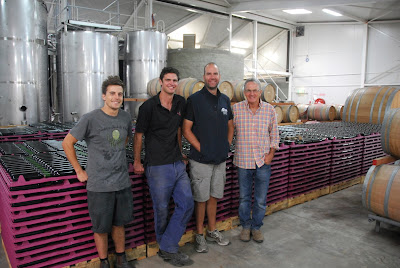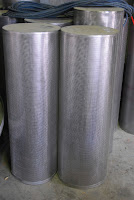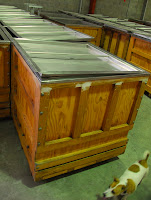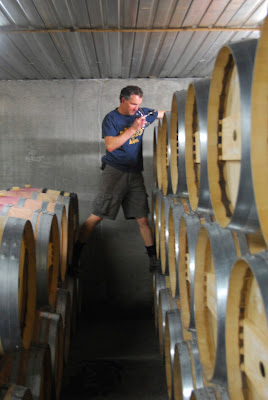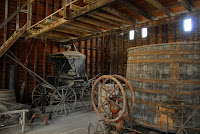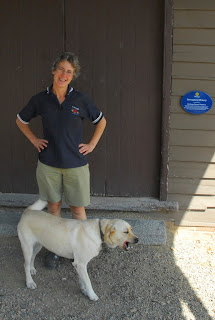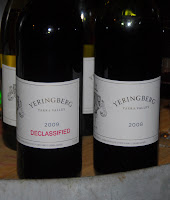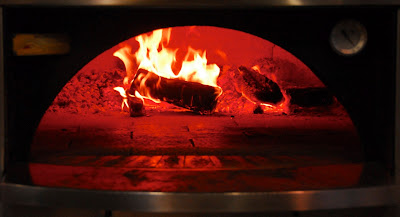To a non-Australian, the drive down to Mornington Peninsula
this morning was as unmistakably Australian a scene as yesterday’s drive to the
Yarra Valley. But on this, my first visit, it felt somewhat more genteel,
wealthier, as well as more scenic, with glimpses of Port Phillip Bay coming in
and out of view. The road in the morning breeze, in parts canopied by giant gum
trees swaying like some game of Oranges and Lemons. It’s rural, but dotted by
grand architectural statements to aspiration, it doesn’t have the farmland feel
of Yarra Valley, it’s more weekender, or triumphant retirement.
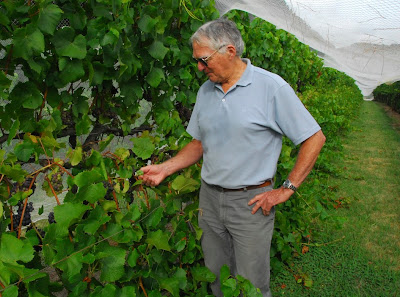 |
| Nat White at Main Ridge |
My first appointment is with Nathanial White at Main Ridge, who was both first in here
in wine, and who remains at the top of the hierarchy for quality and
reputation. He seems bemused by the encroaching Grand Designs. Gently spoken
and thoughtful in tone, Nat explained “I was a civil engineer and I lived in
London for a year in the 1960s. We spent 8 months travelling wine regions in a
tent. My ‘moment’ came in Burgundy on a visit to Château de Pommard. When I came
back I thought the climate looked similar in Mornington Peninsula. I began
planting in 1975 with a range of varieties – Merlot, Gewurztraminer, Riesling,
Cabernet Sauvignon, but Pinot Noir and Chardonnay did best, and that is what we
expanded with.” The original planting in Pinot on the “Half Acre” was to UC
Davis clones D2V5, D2V6, G5V15, and Burgundy clone MV6, with later plantings
from Dijon clones 777, 114 and 115 in the newer “One Acre” block.
Though he clearly had an astute eye for the suitability of
the land, he points to simple good luck as part of his success, as the region
has turned out to be very successful for both Pinot and Chardonnay. His timing
was also fortunate to be an early correspondent student of Brian Croser’s
oenology course at what is today Charles Sturt University. “I enrolled in 1977
and took nine years to complete it. At the time there were no wineries in
Mornington Peninsula, so this practical course was very useful.”
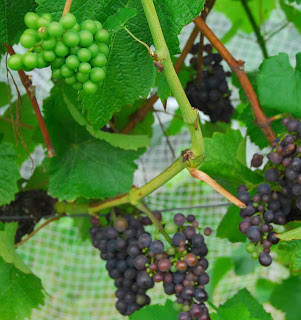 |
| Green bunch thinning at Main Ridge |
Nat points to two key developments in the past thirty years
that have been a boost to quality. Firstly, bunch thinning. “We understood that
bunch thinning put the vine’s energy into better ripening and flavour
development in the remaining bunches, but it wasn’t until a visit to Burgundy
in 2003 that we realised that is wasn’t simply a matter of reducing the number
of bunches, but in selectively removing the green bunches.” My timing - about a month from the start of harvest – was
excellent to see exactly what he meant. “You see all these bunches have changed
colour, but a few are still green. We go through now and drop these bunches. In
a week or two they would also change colour and we wouldn’t no the difference,
but they won’t be as fully ripe, so this is our chance to go through and remove
them.” As an added bonus, Nat found that the wines made after bunch thinning
didn’t require egg white fining as they settled and clarified naturally, and no
longer had the “metallic” (as Nat characterises them) tannins to remove they
used to have. The second development he points to came twenty years ago. “We
began netting the vines. Before that we had to pick to beat the birds, but the
nets give us protection to wait an extra crucial week.”
Main Ridge is a small, single family-scaled estate, set out
immaculately with a beautiful, mature flower garden dividing the vineyard
“backyard” from the small house winery and cellar. Though not quite as bijou as
the “one acre” and “half acre” labels suggest (there are eight acres planted
equally to Pinot and Chardonnay – and a barrel’s worth of Pinot Meunier), it
has the feel of a tranquil English-styled country cottage retreat.
The tasting confirmed in the glass the careful, thoughtful,
quiet tone set by this fascinating visit. The chardonnays are 100% barrel
fermented in French oak barriques, 40% new. 100% malolactic fermentation.
2009 Main Ridge
Chardonnay
Light, bright clear appearance; lovely fresh nose of apple
pie, open and inviting; crisp apple on the palate, buffered by a round textured
mid-palate, this finishes taut, with a ripe but high acid spine. It feels
structured for ageing. Very fine. 92+/100
Nat feels that ten to twelve years ageing is optimal in most
vintages. He especially doesn’t want to see with ageing what he describes as
“bronze” colour notes, and “toffee / honeycomb” on the nose or palate. With
age, they fill out and become a little honeyed, but generally don’t develop the
characters he seeks to avoid, he claimed.
2008 Main Ridge
Chardonnay
Pale and bright appearance; lovely complex and very fine
nose, apple, with mealy notes, a touch of nut oil, this is complex and fresh
and showing a little bottle age complexity on the nose; round-textured, gentley
caressing texture, fine acid spine keeps it animated, good fruit – restrained,
ripe, complex, mealy, sophisticated chardonnay. 93/100
2010 Main Ridge ‘The
Acre’ Pinot Noir
AU$60 on the mailing
list, AU$55 “at the dozen rate”
Fine pale fresh appearance; lovely perfumed nose, pure red
cherry and raspberry, fragrant and fresh; fine, elegant, red fruit expression,
silky mouthfeel with sapid natural acidity and a gently savoury edge on the
finish. Lovely lacy silkiness right through. Reminded me of a very fine Volnay
1er Cru ‘Les Mitans’. Very fine, sophisticated Pinot. 92/100
2010 Main Ridge ‘Half
Acre’ Pinot Noir
AU$70 on the mailing
list, AU$65 “at the dozen rate”
Fine, light fresh colour; a bit more intensity on the nose
compared to The Acre; a deeper shade of fruit and a little more spice on the
nose; that same silkiness on the palate but deeper fruit expression and a wild
/ sauvage element. This is very fine, focused with real Pinot Noir vinosity and
purity, fine tannins on the long finish. Just lovely. One of the finest Pinots
I’ve had from Australia. 94/100
Also at the top of the quality stakes is Port Phillip Estate, just ten minutes
down the road, but a world away. No English tranquillity here. There’s no sight
of an impenetrable forest either, but I still feel like I’ve arrived on the
wrong side of the Maginot Line, France’s ill-fated and obsolete defence against
the 1940 Wehrmacht invasion. I see no guns, no pill-boxes, just concrete.
Surveying its flowing length it begins to look more Memorial than Maginot, but
I still can’t find the door.
 |
| One of these is Port Phillip Estate, one is the Maginot Line, one is the Australian War Memorial in London |
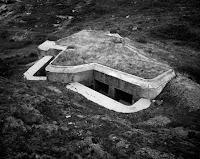
 I approach the only break in the fortress and then, quite
unsettlingly in an Orwellian sort of way, a large door automatically swings open.
I approach the only break in the fortress and then, quite
unsettlingly in an Orwellian sort of way, a large door automatically swings open.
Inside it’s a complete juxtaposition, the flowing line of
the wall softening the large double-height space, and a wall of glass on the
other side of the restaurant-cum-wine tasting room opening up to the softness
of the bush, pond, vineyard and rolling horizon beyond. It’s a neat trick.
Here, it seems, is Mornington Peninsula’s bold statement, like Yarra’s Giant
Steps felt yesterday. Not quite the buzz though, but very cool. Perhaps they
need Phil Sexton’s iPod, or a woodfire pizza oven. Before I put my finger on it
though I’m greeted by Tessa Brown, part of the winemaking team at Port Philip
Estate and sister estate Kooyong.
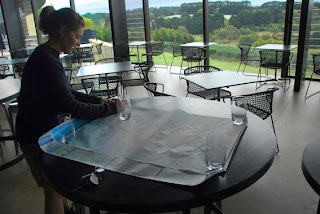 |
| Tessa Brown and her map, Port Phillip Estate |
 |
| Homework |
We begin at the beginning of Mornington Peninsula – the
Paleozoic Age, some 350 million years ago, her tracing paper sketch over a map
of the peninsular pointing out the key geological developments. “Two fault
lines pushed up the peninsula’s soft curved spine. Extrusive [love that word!]
volcanic flows made the basalt bedrock…” It was a wonderfully simplified,
visually-aided lesson in important, and different, soil types at Port Phillip
Estate and Kooyong, but as my eyes glazed over just a little, also a reminder
that I need some remedial reading on the subject if I’m going to keep up. A+
Tessa, C- Linden.
Anyway, it’s important to know there are some key soil types
here, ahem, and yes, that ridge line down the peninsula, offering different
orientations to the climate-moderating influence of all that maritime stuff not
far beyond. That’s about as much as I was able to absorb today, though did gain
the impression (incorrectly?) that Port Phillip Bay perhaps spares Mornington
Peninsula some of the extremes of frost and bushfire suffered in the slightly
more inland Yarra Valley to the north.
Skipping forward +/- 350 million years, the estate’s
modernity is more than a metre thick. “We are 100% ‘passive’ – it’s all solar
energy, the drinking water is collected rainwater, and ‘black water’ is
reclaimed and re-used here…”. Down the very expensive art gallery-like concrete
stairs, that slide down that wall to the cool cellar and winery below. A large
state-of-the-art bottling line is in full swing. Reassuringly, the cellar is
not a showroom for new oak barriques – it’s sophisticated and sensitive in
approach than that. The first thing I see is a beautiful new 6,000 litre oak fudre.
There’s an old saying that if you want to make a small
fortune in the wine making business, start with a large one. It’s quite evident
here that Giorgio and Dianne Gjergja, who bought Port Phillip Estate in 2000
and Kooyong in 2004, and who built that amazing winery in 2009, have deep
pockets. Winemaker Sandro Mosele gets the toys he wants.
All this might appear as vanity, or outright fantasy, if not
for the fact that the line up of wines
is both interesting and good as I was about to discover.
2011 Port Phillip
Estate Sauvignon Blanc
“80% fermentation in
tanks plus some barrels for complexity. We look for minerality and a textural
feel that’s good with food.” AU$24 at the cellar door.
Pale, bright; gently aromatic on the nose, creamy, vegetal
with a touch of blackcurrant leaf and
passionfruit; quite round in style and texture, the acidity pulls in the finish
though there is no greenness. Good, quite stylish sauvignon. 88/100
Tessa: “2011 was a La Niña year with more of that
tropical monsoon weather driving further south, including Victoria. It was the
wettest year since 1974 and extremely cool, but with humidity and rain. We had
problems with botrytis and downy mildew. But for a hard season we pulled
through okay. We did a lot of fruit dropping to ensure a clear crop. On the
flipside we got great acidities and hardly had to acidify anything.”
2011 ‘Clonale by Kooyong’
Chardonnay
Tessa: “Less of a
mineral line, more fruit-forward style.” Whole bunch pressed, native yeast
ferment in French oak, 12% new. AU$30 at the cellar door.
Bright, light appearance; fresh, slightly flinty nose; quite
juicy on the palate, good fruit, touch of just-ripe banana and juicy just-ripe
banana acidity, fruit-driven with appealing freshness and vivacity. Quite
expressive and sumptuous too. This is a very nice chardonnay, great value too.
89/100
2010 Port Phillip
Estate Chardonnay
From a 1.82ha block
planted in 1987. Whole bunch pressed, native yeast, French oak maturation, 15%
new. AU$32 at the cellar door.
Pale, green-gold; lovely complex nose, low key with plenty
of mineral detail; taut and fine on the palate, a finely-honed chardonnay
showing both concentration and elegance. Reserved now, it feels not far from
coming more fruit forward in say, 1 – 3 years. Very good. 90/100
Tessa: “2010 was as close to textbook as we could ask for –
rain at the right intervals, no need to crop thin, no surprises. The Pinots in
particular are built for ageing.”
2009 Kooyong Estate Chardonnay
Estate only fruit,
whole bunch pressed, barrel fermented in French oak, 25% new, native yeast. AU$38
at the cellar door.
Green gold; a fairly ripe expression in contrast to the PPE
’10, but still with good freshness; a fairly voluptuous middle here,
concentrated fruit, round and fleshy, nice juicy stone fruit flavour and
acidity on the finish. Good, bold, drink now. 89/100
Tessa: “2009 gave a small flowering, so a small crop to
begin with, and then summer heat meant we had some burn issues. The wines have
realy intense fruit.”
2007 Kooyong Estate ‘Faultline’ Chardonnay
Single vineyard wine
(1.02ha), as per ‘regular’, 30% new oak. AU$60 at the cellar door.
A touch of colour development; peachy on the nose and
showing development, some savoury notes, fairly opulent; tauter in acid
structure that expected from the nose, with fairly developed flavours. Fully
evolved. Drink up. 86/100
2011 ‘Massale by
Kooyong’ Pinot Noir
Froom Kooyong and
Ballewindi vineyards, 16.27ha. 100% de-stemmed, native yeast, French oak, 15%
new. AU$32 at the cellar door.
Fine, brightly clear glinting ruby; a ripe, spicy nose,
sherberty raspberry and beetroot expression, though a little sulphur reduction
too; taut, slightly sharp acidity, raspberry, though fruit weight and
expression a little masked by reduction right now, some savouriness. Perhaps
not showing quite right at the moment? 85+/100?
2010 Port Phillip
Estate Pinot Noir
From a 5.08ha vineyard
planted in 1988. 100% de-stemmed, native yeast and native malolactic, 12 months
in French oak, 20% new. AU$38 at the cellar door.
Bright clear mid-depth Pinot ruby; lovely fragrant nose, at
the ripe generous end of the Pinot spectrum but still varietally expressed,
crystalline raspberry and dark cherry, a touch of leafy complexity, aromatic;
juicy and ripe on the palate, generous with attractively flavoursome
sticky-edged muscular yet supple tannins. After this opened a little more in
the glass a distinctively pine needle-like note on the nose and palate
developed. Very good. 91/100
2009 Kooyong Estate Pinot Noir
100% estate grown,
winemaking per ‘Massale’, 25% new oak. AU$44 at the cellar door.
Quite full-coloured; a touch reduced on the nose, rich dark
fruit underneath; fleshy, bright, intense fruit, cherries burst forth, plush,
velvety-textured though quite pure still, some spiciness at the end. Long
finish. This has broad appeal, “yum yum!” I wrote, underlined. 90/100
2009 Port Phillip
Estate ‘Morillon’ Pinot Noir
From a 1.01ha vineyard
within the estate, planted 1987. Per the regular bottling, 30% new oak. AU$50
at the cellar door.
Bright, clear, fairly deep colour; a real dark sweet spice
signature to this, a touch of pine, dark fruit, quite fresh; fairly
richly-fruited, firmly-structured, opulent, with a somewhat chewy structure and
some obtrusive warmth of alcohol* on the spicy, pine-laced finish. (* only 13%
despite this impression). Perhaps I didn’t get the right read on this, but it
seemed a little exaggerated in style. 85/100
2009 Kooyong Estate ‘Meres’
Pinot Noir
From single, 2.7ha
vineyard, winemaking per ‘regular’, 30% new oak. AU$68 at the cellar door.
Clear, deepish ruby; a savoury top note on the nose, fine red
cherry fruit, a fragrant note of celery leaf; soft, velvet, fleshy palate,
zippy acidity, red cherry like fruit, fine sticky tannins. Good. 89/100
2008 Kooyong Estate
Pinot Noir
AU$44 at the cellar
door.
Bright garnet, a touch of colour development at the rim;
mature aromas, red cherry with savoury notes overlaid; soft, fuzzy-focus
fleshy-feel, the freshness of fruit has dissipated, savoury, leafy-edged
tannins and a touch of dryness on the slightly austere finish. A bit
disappointing. 85/100
I was too busy chatting to take a note on the 2009 Port
Phillip Estate Shiraz, except that I really liked its meaty-savoury edge, cool
expression and natural feel. A bit Cornas-like I thought and no bad thing.
On the whole, a good line up I thought with the Port Phillip
Estate wines seeming to have an edge of the Kooyong Estate examples, at least
as far as my palate is concerned. Kooyong’s “Clonale” bottling offered some of
the best chardonnay for the price I’ve had in Australia and I wouldn’t hesitate
if I saw it on a restaurant wine list. I’d also be really interested to see
that 2010 Port Phillip Estate Pinot Noir again in a couple of years. Serious
stuff.
Next up a short cellar-door visit to Stonier, the estate with the early export reach to help put
Mornington Peninsula on the international wine map.
2008 Stonier
Mornington Peninsula Chardonnay Pinot Noir
Sparkling. 70% Ch / 30% P.N.
A fresh bready nose with a touch of nougat; fresh, vibrant
mousse, soft-edged ripe acidity, grapefruity tone, still quite yeasty and
fresh. Good 88/100
2010 Stonier
Chardonnay
A fine, fruit-forward style, stone fruit expression, round,
ready. 87/100
2009 Stonier ‘KBS’
Single Vineyard Chardonnay
27 year old vines from the original planting.
Stone fruit expression again though a little more mealy than
the regular bottling on the nose; focused but fleshy, quite round. 90/100
2009 Stonier
‘Lyncroft’ Single Vineyard Chardonnay
From an elevated East-facing site, 10km away
Mineral notes on the nose; cool, fresh, fine textured, well
focused, unupholstered chardonnay that should reward a year or two more in
bottle. Impressive. 91/100
2009 Stonier Reserve
Chardonnay
“A barrel selection
from all sites”.
Quite rich, mouthfilling and mealy. 88/100
At this point I manage to snag assistant winemaker Robin
Gardner as he stepped into the tasting room and I asked a few quick questions –
“We whole bunch press the fruit, settle the juice at 14
degress Celcius, inoculate with two yeast strains – though we are not looking
for a yeast ‘character’. We rack. Around November or December we take the
regular Stonier bottling out, blend the barrels for the reserve and return that
to barrel for around 6 months. Malolactic is natural, but we pull some up. The
regular Stonier sees around 5% new barrels, the single vineyard and Reserve
bottlings around 30% - all French oak. We use 4 coopers selectively, with
medium to medium+ toast.”
Well, that was my 5 minute download. The team were getting
everything ready in the winery. “Picking begins next week”. Back to the wines…
2010 Stonier
‘Peninsula’ Rose
100% Pinot Noir.
Pale and pink – juicy strawberry on nose and palate, nice
acidity. 86/100
2009 Stonier
Mornington Peninsula Pinot Noir
“We buy in some local
fruit from long term growing contracts”.
Fine garnet ruby, mid depth of colour; bright cherryish
fruit – a floral and attractive nose; ripe, soft, supple and delicious fruit,
easy but fragrant in style, soft finish. Very nice. 87/100
2009 Stonier
‘Lyncroft’ Pinot Noir
“A cooler, East-facing
site at 135 metres.”
Mid colour, blue-fruit expression, sweet perfume; juicy,
fairly complex, soft-tectured, the definition is a bit smudged but with good
ripe acidity. Good Pinot. 90/100
2009 Stonier
‘Windmill’ Vineyard Pinot Noir
Fine mid-hued appearance; sweet, leafy-edged nose, a touch
of pine / eucalypt in the aromatics; fine, quite focused – a very fine seam of
pure fruit, fragrant, well structured on lively acidity and ripe supple tannin.
Long. Very very good – wait 3 to 4 years. 92/100
2007 Stonier Reserve
Pinot Noir
“A blend of the best fruit”.
Mid clear garnet, with a touch of development showing at the
edge of the rim; a rich nose, darkish expression, plum, dark cherry and smoke;
soft-textured on entry, sweet, a touch of tea and some savoury elements.
Showing a little development. This is good, though not as clearly focused as
the two ‘09s. 89/100
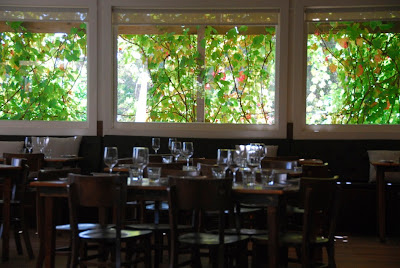 |
| Cafe at Merrick General Store building |
With a little time to spare on the way to my next
appointment, I stopped for lunch at the Merrick’s General Wine Store, which
more or less is Merrick, if you’re looking at a map. Once the rural gabled,
corrugated iron-clad hub for newspapers and supplies, it has seen a ground up
sympathetic restoration and today operates as the cellar door for three small
wineries. But I wasn’t here ot taste, I was here to eat. A happy choice as it
turned out, the simple but sophisticated modern Australian fare reminding me a
little of Prue Leith’s good sense recipes.
The cake cabinet had me drooling. I’ll be back!
My final stop for the day was Paringa Estate, where Business
Manager Samantha Bourke and her colleague had everything lined up for me to
taste when I got there in the late afternoon, so I was straight in –
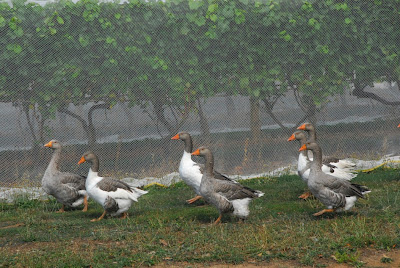 |
| Goose escort to cellar door, Paringa Estate |
2011 Paringa Estate
Riesling
From a 20 year old
vineyard nearby, cool temperature fermentation in stainless steel. AU$20 at the
cellar door.
Water clear and bright; red apple and citrus on the nose;
taut, leanish and dry on the palate. Not especially long. Clean and tidy.
84/100
2010 Paringa Estate
Pinot Gris
Cool temperature
fermentation in stainless steel. AU$20 at the cellar door.
Very pale; apple and little crisp pear on the clean low key
nose; bright, zingy fresh, green apple, some breadth and texture, taut finish.
85/100
2009 Paringa Estate
Viognier
From the Robinson
Vineyard. Barrel-fermented in 4 year old oak. AU$28 at the cellar door.
Pale green gold; fairly cool fresh appley nose, not
especially fragrant; seems quite tight and lean for Viognier on the palate, a
little hint of oiliness the clue to variety. A bit austere for this variety I
think. 82/100
2009 Paringa Estate ‘Peninsula’
Chardonnay
Barrel fermentation
and 10 months in used barriques. AU$22 at the cellar door
From managed contract vineyards in Mornington Peninsula
Pale green gold; low key nose led by a little burnt match
stick; fairly crisp expression on the palate, generous fruit concentration
fairly taut and tightly wrapped right now. Good. 88/100
2010 Paringa Estate
Chardonnay
Barrel fermentation,
40% new, 60% one year old. AU$35 at the cellar door.
Fresh with a touch of vanilla oak on the nose, hint of
caramel – fairly rich; a good combination of focus and creaminess on the
palate, fairly concentrated, banana-spectrum fruit, quite long. Very good.
90/100
2008 Paringa Estate
‘The Paringa’ Chardonnay
Barrel fermented “high
percentage” of new oak, 20% malolactic fermentation. AU$50 at the cellar door.
Bright green-gold; fresh, youthful and oaky on the nose;
generous, glycerine-laden texture on the palate, mouthcoating with lots of
small-berry extract, ripe expression with banana-like fruit, tangy ripe
acidity, and noticeable but manageable alcohol (14.5%) on the finish. This is a
big, bold, fairly old school chardonnay, well made within the context of that
style. 90/100
2011 Paringa Estate
Rose
AU$18 at the cellar
door. From Pinot Noir and Shiraz – the 2011 saw quite a lot of Pinot Noir.
Pale rose; strawberry nose with a bit a whiff of sulphur
dioxide; crisp, a bit hard in texture, some ferment flavours, some alcohol elbowing
the finish which finishes a touch bitter. Clean and crisp, but a bit stern. 79/100
2010 Paringa Estate
‘Peninsula’ Pinot Noir
AU$27 at the cellar
door.
Bright, very clear mid-spectrum Pinot colour; bright
raspberry, leaf, red cherry nose; quite big, voluptuous and soft,
glycerine-laden though some juicy acidity carries the middle along to a
satisfyingly fruity and fragrant finish. A youthfully appealing, fleshy Pinot.
89/100
2009 Paringa Estate
Pinot Noir
AU$60 at the cellar
door.
Clear, deepish Pinot shade of ruby; opulent dark cherry
nose, quite sexy and spicy and bold; bold ripe fleshy Pinot on the palate, held
into shape by finely structured tannins. Long, fragrant, spicy finish. A very
good Pinot in the fleshy, spicy camp. 90/100
2008 Paringa Estate
‘The Paringa’ Pinot Noir
AU$90 at the cellar
door.
Richly-scented dark cherry spectrum Pinot nose; complex and
fragrant – ripe cherry, quite scented, good flesh, high quality fruit, a touch
of leafiness, finely structured, cherry pit notes, seductively scented finish.
This offers plenty of complexity and pleasure now, but should reward cellaring.
91/100
2010 Paringa Estate
‘The Paringa’ Pinot Noir
In bottle but not yet
released – kindly opened for me by Lindsay McCall
This took some time to get going in the glass. A cool,
floral edged aromatic profile emerged from the glass, leafy notes, very fine;
juicy, taut, red cherry fruit, with the floral, scented notes building with
time, finely structured, quite fulsome weight (14.5% abv), but stays juicy right
through to the long finish. 92+/100
2009 Paringa Estate
‘Peninsula’ Shiraz
AU$25 at the cellar
door.
Licorice-edged blackberry nose with a touch of meat and
black pepper; blackberry fruit on the palate, coolish expression, a little
dryness in the tannins at the end. 87/100
2008 Paringa Estate
Shiraz
AU$50 at the cellar
door.
Fine blackberry and white pepper nose follows through to the
palate which is fleshy and bright. A lively, aromatically pleasing shiraz,
though with fine underlying structure for mid-term ageing. Very good. 91/100
2007 Paringa Estate
‘The Paringa’ Shiraz
AU$80 at the cellar
door.
Quite spicy, though the sweet and savoury-edged fruit has
swallowed all that new oak (100%) well, leaving this with a “La Chapelle”-like
combination of sweet blackberry fruit, meatiness and savoury edge. A bold
(14.5% abv), Hermitage-like wine, it is good, though not as graceful as the ’08
‘regular’ estate bottling. 90/100
The Paringa Estate was founded by former school teacher
Lindsay McCall, who began planting in this ex-orchard in 1985. The venture has
been a great success, with numerous trophies and championship wins on the
Australian judging circuit, and a solid following in the domestic secondary
market at Langton’s.
(Paringa Estate is distributed in the UK by my old friend Amelia Jukes at
Hallowed Ground and in Hong Kong by Ponti Trading)
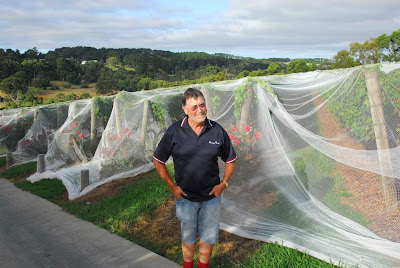 |
| Paringa Estate's Lindsay McCall |
Lindsay gave generously of his time with me after he popped
in to see me in the tasting room half way through the whites. I mentioned that
on my way in to see him at No.44 Paringa Road, I had noticed a large house and
vineyard for sale just up the road at No.52. “They want AU$3.5 million for it –
the house has pretty commanding views of the bay, and it comes with seven acres
under vine – which we manage under contract.” It seems growth in Mornington
Peninsula as a wine district may be constrained when vineyard land must be
bought at Melbourne playground prices. While the Lucky Country continues to dig
all that rare stuff out of the ground, that trend seems unlikely to change.
What a couple of days I had in Yarra Valley and Mornington
Peninsula. To say that was a bit quick would be a bit of an understatement. But
the taster I experienced left me wanting more.
Next stop, Martinborough, New Zealand…
